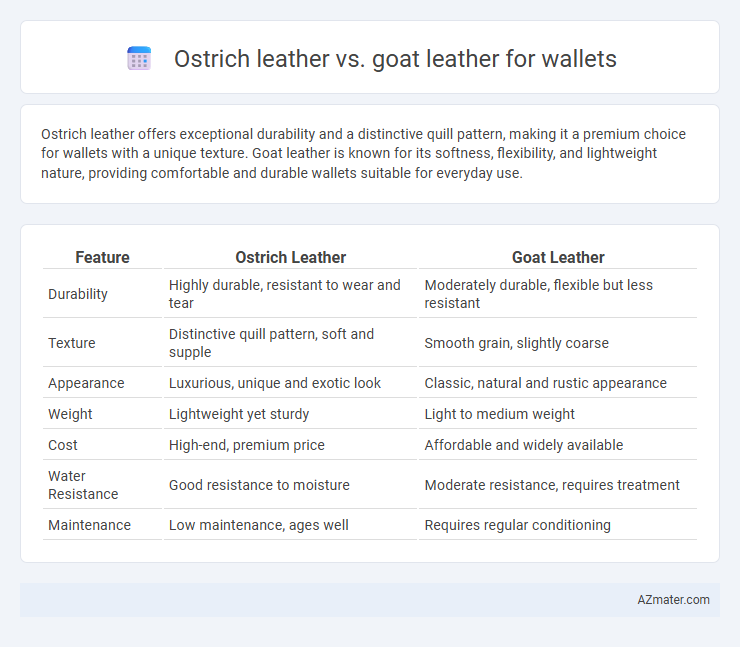Ostrich leather offers exceptional durability and a distinctive quill pattern, making it a premium choice for wallets with a unique texture. Goat leather is known for its softness, flexibility, and lightweight nature, providing comfortable and durable wallets suitable for everyday use.
Table of Comparison
| Feature | Ostrich Leather | Goat Leather |
|---|---|---|
| Durability | Highly durable, resistant to wear and tear | Moderately durable, flexible but less resistant |
| Texture | Distinctive quill pattern, soft and supple | Smooth grain, slightly coarse |
| Appearance | Luxurious, unique and exotic look | Classic, natural and rustic appearance |
| Weight | Lightweight yet sturdy | Light to medium weight |
| Cost | High-end, premium price | Affordable and widely available |
| Water Resistance | Good resistance to moisture | Moderate resistance, requires treatment |
| Maintenance | Low maintenance, ages well | Requires regular conditioning |
Introduction to Ostrich and Goat Leather
Ostrich leather, known for its distinctive quill follicle pattern, offers exceptional durability and a luxurious texture ideal for premium wallets. Goat leather, valued for its natural softness, fine grain, and lightweight quality, provides excellent flexibility and resilience in wallet craftsmanship. Both leathers are prized in the leather industry, but ostrich leather stands out for its unique appearance and strength, while goat leather emphasizes comfort and supple touch.
Origins and Production Processes
Ostrich leather originates primarily from South Africa and is renowned for its distinct quill follicle pattern, resulting from the feather follicles on the bird's skin. The production process involves gentle tanning methods to preserve the natural texture and strength, making it highly durable and supple for wallet manufacturing. Goat leather, sourced mainly from Southeast Asia, undergoes a straightforward tanning process that enhances its natural grain and flexibility, offering lightweight and resilient wallet options.
Unique Characteristics of Ostrich Leather
Ostrich leather stands out in wallet crafting due to its distinctive quill follicle pattern, providing a unique textured surface that is both visually appealing and highly durable. Its natural oils make the leather exceptionally supple and resistant to cracking, ensuring longevity even with frequent use. Compared to goat leather, ostrich leather offers a more luxurious feel and a striking appearance, making it a premium choice for sophisticated wallets.
Distinct Features of Goat Leather
Goat leather is known for its natural durability and lightweight texture, featuring a distinctive grain pattern that offers a unique aesthetic for wallets. Its softness and flexibility make it highly resistant to cracking and wear, providing long-lasting use while maintaining a comfortable feel. Unlike ostrich leather, goat leather tends to be more affordable and easier to maintain without sacrificing style or strength.
Durability Comparison: Ostrich vs Goat Leather
Ostrich leather exhibits exceptional durability due to its unique quill follicle pattern, providing natural resistance to wear and tear, making it ideal for long-lasting wallets. Goat leather, known for its lightweight and supple texture, offers moderate durability but tends to be less resistant to scratches and scuffs compared to ostrich leather. In terms of longevity, ostrich leather wallets outperform goat leather counterparts, maintaining their aesthetic and structural integrity over extended use.
Texture and Appearance Differences
Ostrich leather features a distinctive quill follicle pattern with raised bumps, giving wallets a unique, luxurious texture and a highly durable surface that ages beautifully with a natural sheen. Goat leather, in contrast, possesses a finer, more uniform grain with a supple, matte finish that offers a softer hand feel and subtle elegance. The pronounced texture of ostrich leather makes wallets visually striking and ideal for statement pieces, while goat leather's smooth look suits classic, understated designs.
Cost and Value Analysis
Ostrich leather wallets typically command higher prices due to their unique quill pattern and durability, offering a luxurious aesthetic that appeals to premium markets. Goat leather wallets present a more affordable option, combining softness with reasonable wear resistance, making them suitable for cost-conscious consumers seeking quality. The value analysis favors ostrich leather for long-term investment in exclusivity and resilience, while goat leather balances cost efficiency with satisfactory performance.
Care and Maintenance Requirements
Ostrich leather wallets require careful maintenance due to their unique quill follicle pattern, necessitating regular cleaning with a soft, damp cloth and conditioning with specialized leather products to retain softness and prevent cracking. Goat leather wallets are more durable and flexible, demanding less intensive care but still benefit from occasional conditioning and protection from excessive moisture to prevent stiffness and mildew. Proper care for both types extends wallet lifespan, preserving their distinct textures and appearance.
Eco-Friendliness and Sustainability
Ostrich leather offers durability and unique texture while often coming from birds farmed for meat, supporting sustainable use of animal byproducts. Goat leather is lightweight, pliable, and sourced from widely farmed animals with a smaller ecological footprint due to efficient land use and lower greenhouse gas emissions. Both leathers provide eco-friendly wallet options compared to synthetic alternatives, but goat leather generally scores higher in sustainability metrics due to faster regeneration rates and lower resource consumption.
Choosing the Right Leather for Your Wallet
Ostrich leather offers exceptional durability and a distinctive textured pattern with its characteristic quill follicles, making it a luxurious choice for wallets that demand both style and longevity. Goat leather, known for its softness, flexibility, and fine grain, provides a lightweight and comfortable option ideal for everyday use without sacrificing resilience. When choosing the right leather for your wallet, consider ostrich leather for premium aesthetics and robustness, or goat leather for a practical, supple feel that ages beautifully with wear.

Infographic: Ostrich leather vs Goat leather for Wallet
 azmater.com
azmater.com